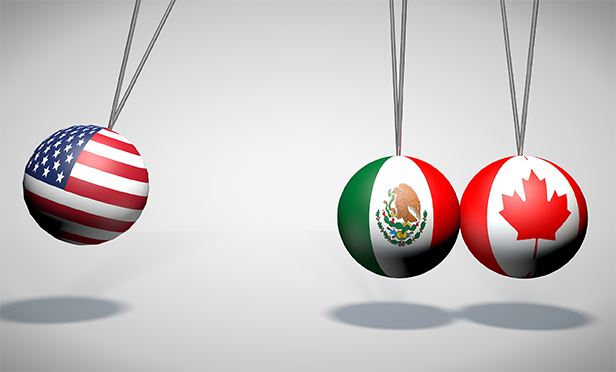 As we finish out the first quarter of 2018, talks around renegotiating the North American Free Trade Agreement (NAFTA) cast a shadow of uncertainty on the future economic health of the United States, Mexico, and Canada. With the Trump administration talking tough and threatening to pull out of the trade deal, business leaders are finding it difficult to measure risks in North American markets. Although a change to NAFTA could indeed have major effects on companies that do business in the region, the good news is that signs point to economic resilience.
As we finish out the first quarter of 2018, talks around renegotiating the North American Free Trade Agreement (NAFTA) cast a shadow of uncertainty on the future economic health of the United States, Mexico, and Canada. With the Trump administration talking tough and threatening to pull out of the trade deal, business leaders are finding it difficult to measure risks in North American markets. Although a change to NAFTA could indeed have major effects on companies that do business in the region, the good news is that signs point to economic resilience.
In support of our trade credit insurance business, Atradius recently released a report on the economic health and anticipated future performance of major North and Central American countries. That analysis anticipates economic growth of 2.5 percent or higher for the United States in 2018—a continuation of the momentum experienced in 2017, which saw a 2.2 percent increase. This year's projected growth in the U.S. economy will be facilitated by the following factors:
- Steadily decreasing corporate insolvencies. Insolvencies spiked following the 2008 recession and have steadily decreased ever since. A 2 percent decrease is predicted for 2018.
- Robust growth in consumption. Accounting for nearly 70 percent of U.S. GDP, and the main engine of economic growth since 2014, household consumption is expected to remain robust in 2018, increasing 2.5 percent over 2017. U.S. private consumption is aided by falling unemployment (expected to fall below 4 percent in 2018), wage growth, higher home prices, a healthy stock market, and a low household saving rate.
- Rising exports. Political uncertainty and a stronger euro caused the dollar to weaken in 2017 compared with 2016. As a result, analysts expect U.S. exports to increase another 3 percent in 2018, after contracting in 2016 and recovering in 2017. Rising exports signal an expanding manufacturing sector, which is anticipated to grow 2.6 percent this year.
Recent changes to tax law are also expected to positively impact the U.S. economy, particularly aiding exports, investment, and private consumption. The December 2017 tax overhaul is predicted to amount to approximately $1.5 trillion in tax relief over the coming decade, mainly through a 14 percent decrease in the corporate tax rate and temporary tax breaks for both businesses and individuals. However, uncertainties remain around whether these changes will strain public finances in the coming years.
Canada and Mexico
The Atradius report is less rosy in its growth projections for Mexico and Canada. In 2017, Canada's economic growth accelerated to 3 percent, representing a slight rebound from the 2015 and 2016 slowdown caused by decreased oil prices and slowed investments in mining, quarrying, and oil and gas extraction. We do not expect this acceleration to continue into 2018. Instead, overall economic growth in Canada will likely dip slightly this year, to 2 percent, due to a slowdown in private consumption and government spending.
Although the rate of Canadian insolvency declined in 2017, no further decrease is predicted for this year. Finally, inflation is expected to increase slightly, but should remain below 2 percent.
Atradius projects that Mexico's economic performance will hold steady this year. Last year, that country's growth outpaced expectations, coming in at just above 2 percent despite decreased oil production, tight fiscal and monetary policies, and uncertainties about the nation's relationship with the United States. We expect Mexico's growth to remain in the 2 percent range in 2018, dampened by tight fiscal policies and domestic uncertainty surrounding NAFTA and the country's upcoming elections.
The good news is that Mexico appears resilient against external shocks, thanks to a sound policy framework, a healthy banking system, solid external balances, and abundant official reserves. Exchange rate fluctuations also serve as a shock absorber for the economy, helped by the fact that Mexico's foreign currency debt remains limited. The liquidity potential from a precautionary $88 billion credit line with the IMF, which Mexico can draw on during adverse global credit conditions, further reduces transfer and convertibility risks.
The Shadow of NAFTA
Political uncertainty, particularly surrounding the NAFTA renegotiations, remains the largest downside risk to North American economies. Each of these countries will likely feel some aftershocks, although the degree will vary. The current expectations are that the United States will moderate its most radical proposals, and that negotiations will end in 2018 with a revised NAFTA framework.
 Should the agreement collapse entirely, trade between the U.S., Canada, and Mexico will likely revert to World Trade Organization (WTO) rules, which set bands within which trade tariffs can be set. The NAFTA agreement imposes a zero tariff for most goods while WTO imposes an average of between 3.5 percent and 7.1 percent. Industry sectors such as automotive, agriculture, and apparel could be most affected.
Should the agreement collapse entirely, trade between the U.S., Canada, and Mexico will likely revert to World Trade Organization (WTO) rules, which set bands within which trade tariffs can be set. The NAFTA agreement imposes a zero tariff for most goods while WTO imposes an average of between 3.5 percent and 7.1 percent. Industry sectors such as automotive, agriculture, and apparel could be most affected.
Due to its high economic dependence on the United States, Mexico is most vulnerable to NAFTA shocks, although the country is expected to rebound from any possible renegotiation outcome. If WTO rules were to take effect, Mexico would not be severely impacted, given that the tariffs on the country's main export goods to the U.S. would be relatively low. Mexico's free-trade agreements with 46 countries also help build the country's resilience, whatever happens with the United States, as does Mexico's renewed focus on strengthening its relationships with the Pacific Alliance, Mercosur, and the EU.
Robust policymaking serves as an additional protection against a downward spiral in the event that NAFTA were to fall through. Foreign debt ratios are under control, and Mexican authorities have preemptively covered external borrowing needs and are replacing existing bonds with new bonds on more favorable terms. At the same time, a new currency hedging program will help the Bank of Mexico avoid raising interest rates to reduce pressure on the peso. Finally, a strong financial sector and competitive advantages for manufacturing businesses that export to non-U.S. markets should help Mexico maintain strong foreign investment in the medium to long term.
For Canada, more than three-quarters of all exports go to the United States, so that country's short-term economic outlook could be negatively impacted if NAFTA falls through or if there is an escalation of U.S. trade disputes that result in additional trade barriers. President Trump, who has specifically complained about the U.S. trade deficit with Canada, threatens to place additional tariffs on some Canadian lumber exports; the Trump administration has already imposed a 300 percent import tax on a jet plane produced by Canadian aerospace firm Bombardier after Boeing claimed the company was selling the plane at below-cost. To compensate for any negative fallout from the NAFTA renegotiation, Canada has been actively pursuing free trade agreements with the European Union and the Trans-Pacific Partnership.
The United States is not immune from the fallout either, should the current NAFTA agreement fall by the wayside. For instance, lower investment due to heightened uncertainty or impediments to cross-border transactions could have severe implications for U.S. businesses. Whether WTO rules are reinstated or the terms of the current NAFTA agreement are amended, barriers to export will likely increase, as well as tariffs for Canadian or Mexican imports from the United States. The large sectors of U.S. businesses that depend heavily on Mexican supply chains, like the automotive industry, would likely feel a significant strain.
Like Mexico, the U.S. also has some potential protections against NAFTA disintegration causing an economic downturn. Inflation is likely to increase moderately, to 2.2 percent, this year, leaving the Federal Reserve leeway in its monetary policy. This is notable, as further tightening is necessary to create the monetary tools needed to stabilize the U.S. economy when downturns threaten.
Assessing Additional Downside Risks
Downside risks outside of the threat of NAFTA renegotiations remain for all three major North American countries. In the United States, even aside from NAFTA, the main downside risk is trade policy. However, concerns about a surge in U.S. protectionism have receded slightly, as policymaking over the past year has been less radical than anticipated.
In Canada, where private consumption is the main engine for growth, a high rate of household debt is concerning. Most consumer borrowing has gone into homes. As a result, property values have risen and interest rates are low. Housing is currently overvalued, and household debt, mainly in the form of mortgages, has reached nearly 170 percent of post-tax income. The ratio of household debt to GDP in Canada is now more than 100 percent—a precarious situation should the nation face an economic downturn. Hopefully, recent changes to Canada's tax and housing financing policies, as well as two small increases of the benchmark overnight lending rate by the central bank, will succeed in slightly cooling down the overheated property market.
In Mexico, economic risks include rising consumer prices and tightening monetary policy. In 2017, consumer prices rose nearly 7 percent, well ahead of the Central Bank's projection of 2 percent to 4 percent. The short-term economic outlook is dampened by the peso's continued vulnerability to changing market sentiment. To protect the peso and relieve inflationary pressures, the Bank of Mexico has increased its benchmark rate several times, from 4.25 percent in 2016 to 7 percent in 2017. In addition, poor domestic security linked to drug-related violence and rampant corruption remains a major issue: These factors dampen the business environment and hamper economic performance by discouraging investment.
There are a few protections businesses can put in place to insulate themselves against downside risks, including the economic uncertainty caused by NAFTA renegotiations. Trade credit insurance can protect companies against the failure of their customers to pay because of insolvency, default, or bankruptcy. In addition, businesses should keep abreast of market trends and forecasts. For those opting for insurance, most trade credit insurers can provide thorough and regular analysis of markets around the world.
See also:
- Winners and Losers from Shifts in U.S. Trade Policy
- How Renegotiation of NAFTA Might Affect FX
- NAFTA Nations Said Likely to Adopt Non-Binding Currency Pledge
 David Huey was appointed to the position of president–regional director of Atradius Trade Credit Insurance, Inc. in May 2014. In this role, he is responsible for Atradius' business activities throughout the United States, Canada, and Mexico, working on developing the local markets; nurturing customer, broker, and staff relationships; and achieving strategic goals. David joined Atradius in 2006 as the managing director of Australia and New Zealand, where he spent seven years building the Oceania business and the support network for Asian expansion.
David Huey was appointed to the position of president–regional director of Atradius Trade Credit Insurance, Inc. in May 2014. In this role, he is responsible for Atradius' business activities throughout the United States, Canada, and Mexico, working on developing the local markets; nurturing customer, broker, and staff relationships; and achieving strategic goals. David joined Atradius in 2006 as the managing director of Australia and New Zealand, where he spent seven years building the Oceania business and the support network for Asian expansion.
© Touchpoint Markets, All Rights Reserved. Request academic re-use from www.copyright.com. All other uses, submit a request to [email protected]. For more inforrmation visit Asset & Logo Licensing.



